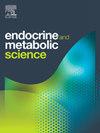Correlation between abdominal obesity and hyperuricaemia in individuals with type 2 diabetes mellitus: A case–control study
Q3 Medicine
引用次数: 0
Abstract
Background
Obesity is associated with hyperuricaemia in the general population; however, that relationship has not been studied in detail in patients with type 2 diabetes mellitus (T2DM), nor has the possibility of sex differences in that relationship been investigated.
Methods
A retrospective case–control study was conducted. We explored the correlation between abdominal obesity and hyperuricaemia among 315 Chinese patients with T2DM aged 27–64 years who had received community health services between January 2021 and August 2022. Abdominal obesity was defined as a waist circumference ≥ 85.0 cm in females and ≥ 90.0 cm in males. Hyperuricaemia was defined as a serum uric acid level > 7.0 mg/dL in males and postmenopausal females, > 6.0 mg/dL in premenopausal females, or receiving medical treatment for hyperuricaemia. The male and female groups were each separately divided into two additional groups: those with abdominal obesity and those without abdominal obesity. Odds ratios (OR) and 95 % confidence intervals (CI) for the risk of hyperuricaemia were calculated using a logistic regression model.
Results
The prevalence of hyperuricaemia in male and female patients in the study area was 42.86 % and 28.00 %, respectively. Abdominal obesity (OR = 3.369, 95 % CI = 1.031–11.009, P value <0.05) was the determinant variable for hyperuricaemia among male patients with T2DM but not among female patients. There was no significant difference in the prevalence of hyperuricaemia between male or female T2DM patients with different body mass index (BMI) levels.
Conclusions
Our study revealed that abdominal obesity, but not overall obesity, was associated with an increased risk of hyperuricaemia in male patients with T2DM. Neither abdominal obesity nor overall obesity was associated with an increased risk of hyperuricaemia in female patients with T2DM. Abdominal obesity is a more effective predictor of hyperuricaemia than overall obesity is in male patients with T2DM.
2型糖尿病患者腹部肥胖与高尿酸血症的相关性:一项病例对照研究
背景:在一般人群中,肥胖与高尿酸血症相关;然而,这种关系尚未在2型糖尿病(T2DM)患者中进行详细研究,也没有调查这种关系中性别差异的可能性。方法采用回顾性病例对照研究。我们探讨了315名27-64岁的中国T2DM患者腹部肥胖与高尿酸血症的相关性,这些患者在2021年1月至2022年8月期间接受了社区卫生服务。腹部肥胖定义为女性腰围≥85.0 cm,男性腰围≥90.0 cm。高尿酸血症被定义为血清尿酸水平[gt;7.0 mg/dL男性和绝经后女性,>;绝经前女性6.0 mg/dL,或接受高尿酸血症药物治疗。男性和女性分别被分成另外两组:腹部肥胖组和非腹部肥胖组。使用逻辑回归模型计算高尿酸血症风险的优势比(OR)和95%置信区间(CI)。结果研究区高尿酸血症男、女患病率分别为42.86%和28.00%。腹部肥胖(OR = 3.369, 95% CI = 1.031-11.009, P值<;0.05)是男性T2DM患者高尿酸血症的决定变量,而非女性T2DM患者。不同体重指数(BMI)水平的男性和女性2型糖尿病患者的高尿酸血症患病率无显著差异。一项研究表明,腹部肥胖与男性2型糖尿病患者高尿酸血症的风险增加有关,而不是整体肥胖。在女性T2DM患者中,腹部肥胖和整体肥胖均与高尿酸血症风险增加无关。在男性2型糖尿病患者中,腹部肥胖比整体肥胖更能有效地预测高尿酸血症。
本文章由计算机程序翻译,如有差异,请以英文原文为准。
求助全文
约1分钟内获得全文
求助全文
来源期刊

Endocrine and Metabolic Science
Medicine-Endocrinology, Diabetes and Metabolism
CiteScore
2.80
自引率
0.00%
发文量
4
审稿时长
84 days
 求助内容:
求助内容: 应助结果提醒方式:
应助结果提醒方式:


